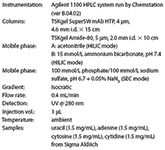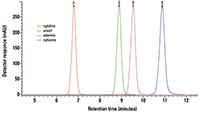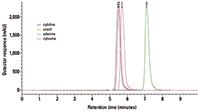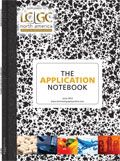Separation of Nucleobases Using TSKgel SuperSW mAb HTP Column in HILIC Mode
Hydrophilic interaction liquid chromatography (HILIC) is one of the fastest growing modes of separation, in which any polar chromatographic surface can be used.
Hydrophilic interaction liquid chromatography (HILIC) is one of the fastest growing modes of separation, in which any polar chromatographic surface can be used. Chemically bonded diol coated phases, as found in TSKgel SW size exclusion chromatography (SEC) columns, demonstrate high polarity and hydrogen bonding properties and do not contain ionizable groups other than the unreacted residual silanols, making them appropriate for HILIC mode.
For many years, SEC columns have been used to separate various nucleic acid species such as DNA, RNA, and tRNA as well as their constituent bases, adenine, guanine, thymine, cytosine, and uracil. In medicine, several primary nucleobases are the basis for the nucleoside analogues and other synthetic analogs which are used as anticancer and antiviral agents. Nucleobase modifications are the basis of oligonucleotide-based therapeutics, making their purification very important.
The TSKgel SuperSW mAb HTP column is a newly introduced SEC column designed for the high throughput separation of monoclonal antibodies from their high and low molecular mass variants. TSKgel SuperSW mAb HTP has a diol coating to minimize secondary interactions which may occur in SEC separations. This note demonstrates the benefits of using a TSKgel SuperSW mAb HTP column in HILIC mode for the superior resolution of four nucleobases, as opposed to using the column in SEC mode or using a HILIC column.
Materials and Methods

Results and Discussion
Figure 1 illustrates the separation of four nucleobases using the TSKgel SuperSW mAb HTP column in HILIC mode with 15 mmol/L ammonium bicarbonate, pH 7.4 as mobile phase B. It is important to note that the order of elution of the analytes does not correlate with their molecular mass (as in SEC separations), but instead is based on their relative hydrophilicity.

Figure 1: Separation of four nucleobases using TSKgel SuperSW mAb HTP column in HILIC mode at pH 7.4.
Figure 2 illustrates the separation of the four nucleobases on the TSKgel SuperSW mAb HTP column using conventional SEC conditions. As expected, due to the similarities in molecular masses between the four compounds, significant interference is observed amongst the peaks of interest, particularly the three pyrimidine derivatives, when separated on the TSKgel SuperSW mAb HTP column under SEC conditions. The late elution of adenine (relative to the other three compounds) may be attributed to possible interactions between the stationary phase and the derivatized purine compound, leading to a shift towards longer retention time.

Figure 2: Separation of nucleobases using the TSKgel SuperSW mAb HTP column under conventional SEC conditions.
In an effort to explore the novelty of the separation of nucleobases using the TSKgel SuperSW mAb HTP column in HILIC mode, the same separation was carried out using a TSKgel Amide-80 HILIC column. The use of the TSKgel Amide-80 column yields very poor separation of the four nucleobases with virtually no retention of any of the components (Figure 3).

Figure 3: Separation of nucleobases using the TSKgel Amide-80 HILIC column.
Conclusions
This work illustrates the novelty and utility of the TSKgel SuperSW mAb HTP column as a diol-functionalized HILIC column for the high resolution separation of nucleobases on the basis of their relative hydrophilicity, rather than differences in their relative molecular mass. As shown, markedly different separation profiles are observed with the use of the TSKgel Amide-80 HILIC column under identical chromatographic conditions. Additionally, nucleobase separation using the TSKgel SuperSW mAb HTP under conventional SEC conditions yielded poor resolution of all components, making it an ineffective mode of separation for this application. The TSKgel SuperSW mAb HTP column, while designed for SEC separation of monoclonal antibodies, is an extremely effective tool in HILIC mode that should be considered for the fast separation of nucleobases.
Tosoh Bioscience and TSKgel are registered trademarks of Tosoh Corporation.

Tosoh Bioscience LLC
3604 Horizon Drive, Suite 100, King of Prussia, PA 19406
tel. (484) 805-1219, fax (610) 272-3028
Website: www.tosohbioscience.com

SEC-MALS of Antibody Therapeutics—A Robust Method for In-Depth Sample Characterization
June 1st 2022Monoclonal antibodies (mAbs) are effective therapeutics for cancers, auto-immune diseases, viral infections, and other diseases. Recent developments in antibody therapeutics aim to add more specific binding regions (bi- and multi-specificity) to increase their effectiveness and/or to downsize the molecule to the specific binding regions (for example, scFv or Fab fragment) to achieve better penetration of the tissue. As the molecule gets more complex, the possible high and low molecular weight (H/LMW) impurities become more complex, too. In order to accurately analyze the various species, more advanced detection than ultraviolet (UV) is required to characterize a mAb sample.

.png&w=3840&q=75)

.png&w=3840&q=75)



.png&w=3840&q=75)



.png&w=3840&q=75)














